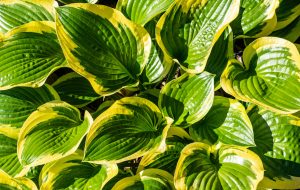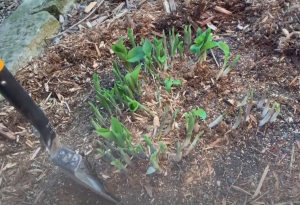Question: I would like to propagate my favorite hosta, and am unsure about the timing and technique. What methods are recommended for this type of perennial plant?
By Rachel Campbell, Piedmont Master Gardener Intern
Hostas are a very popular perennial because of the wide variety of leaf shape, size, texture and color. The bell-like flowers hover over the top of the plants and add a delicate beauty to the landscape. These easy- care, shade-loving plants are adaptable to many sites and soil conditions.
Almost everyone who has plants has encountered the process of propagation. For example, some simple forms of propagation include starting a plant from seed, rooting a houseplant stem in water, cutting and planting a young plant sprouting from the parent or planting a succulent leaf directly in a pot.

What is Propagation?
Propagation is the process of creating a new plant from an existing one. There are two general types of propagation: sexual and asexual. Sexual propagation involves pollination of the plant and fertilization of an egg with sperm to create a seed. If the seed germinates successfully, it will produce a new plant. Asexual propagation involves taking another part of a plant (stems, roots and/or leaves) to produce a new genetically identical plant or plants. Both methods have their advantages and drawbacks. Sexual propagation produces genetically varied plants, which decreases the risk of spreading disease and may make them more adaptable to changing growing conditions. However, some of these plants may have undesirable traits and may take longer to flower and mature. Asexual propagation gives the cloned plant a head-start in reaching maturity and usually perpetuates the desired traits of the parent plant. On the other hand, the lack of diversity can make these plants more susceptible to disease and less able to adjust to new environmental conditions.

Which Method to Use?
The best methods of asexual propagation (cuttings, layering, division, budding/grafting or tissue culture) vary from plant to plant based on its growth habit. Some plants can be propagated by only one method or one method produces a plant sooner than another. Doing some upfront research on how the plant grows is key.
For vegetable and annual flowering plants, the fastest method is to sow the seeds, which mimics the natural way these plants reproduce. Tropical plants and houseplants are often propagated by rooted cuttings, which can reproduce these types of plants faster and more reliably than propagation by seed. Mature perennial plants with a thick fleshy crown (the root-shoot junction) and a clumping tightly packed root system are often propagated by division. The crowns spread year after year to form newly rooted shoots, that can then be split off and planted to produce new plants.
What is the Best Method for Propagating Hostas?
Although hostas can be propagated from seeds or tissue culture, division is the easiest, fastest and most reliable way produce them at home. The crown and root structure of the divided plant retains the moisture and nutrients necessary to promote healthy growth. In addition, dividing perennials rejuvenates older plants, controls parent plant size, reduces overcrowding and produces exact replicas of the hosta’s bloom time, color, shape, size and growth habit.
Timing of Division
Hostas can be divided in either the spring or the fall. However, many sources recommend dividing perennials after active growing and flowering is over, so that the plant’s energy can be directed to the roots and foliage rather than to the flowers. To follow these guidelines, divide spring-blooming hostas in the fall and late-summer or fall blooming hostas in the spring.
In the spring, divide the plants just as new shoots are beginning to emerge. Their roots will have stored up energy during the winter and the plants will benefit from spring rains and an entire growing season to become established. Be sure to wait to divide plants until after the threat of killing frosts are over.
Dividing the plant in the fall will give the root system the winter to become established and will save the new divisions the stress of the summer heat. Plant divisions up to four weeks before the soil freezes so your new plants are acclimated.
Guidelines on Dividing Hostas
Before you start, be sure to have a plan and the tools and materials needed.
- Choose areas in your landscape that are suitable for growing hostas. Hostas perform best in part shade but can survive in deep shade (less than 4 hours of sun). They thrive in well-drained soil rich in organic matter but can tolerate many kinds of soil conditions.
- Do a soil test and follow any recommendations, if one has not been done in the last two to four years. Be sure to amend the soil, if needed, before replanting the parent plant and the divisions.
- Divide and plant the divisions on a cloudy day so the plants don’t dry out.
- Water your hosta the day before to hydrate it and soften the soil.
- Use a freshly cleaned and disinfected spade, knife or fork to dig up the parent plant as gently as possible.
- Remove loose dirt around the roots and remove the vigorous side shoots from the crown.
- Divide the crown to create new divisions with three to five shoots each and a generous mass of healthy roots. Leave the middle of the crown undisturbed, unless it is experiencing dieback.
- Use either your hands or gardening tools to tease the roots apart and separate the shoots from each other.
- Plant the new divisions with the roots pointing downward and the eyes (growing tips on the crown) visible at the soil surface. Space plants so they can reach mature size without being crowded. Plant divisions as soon as possible or if storing them temporarily, keep them moist and shaded until replanted.
- Apply two to four inches of mulch around, but not on the crown to conserve water and maintain soil temperature.
- Water thoroughly after planting. If planting the divisions in the spring, be sure to water enough so the plant is not stressed during dry periods as it begins to warm up. If planting in the fall, watering can be less frequent because the plant will go dormant in the winter season.
- Avoid these common mistakes gardeners make in dividing perennials.
- For the easiest and most successful results, divide hosta plants that are between three and five years old. It is more difficult to separate crowns and roots from the denser, older hostas.
Post-Division Care for Hostas
- Be sure plants receive one inch of water per week.
- Keep plants mulched.
- If a soil test indicates fertilizer is necessary, apply as leaves emerge and again before flowering.
- Deadhead flowers, trim off dead leaves and cut off flower stalks after blooms fade.
- Clean up the hosta bed at the end of the season to reduce the risk of disease and insect pests.
More Information
Explore the videos and resources on the American Hosta Society website. In addition, after mastering the technique for dividing hostas, you may want to try your hand at propagating other perennials by division or other means of propagation.
Featured Image: Photo by Christin Noelle on Unsplash
References
“Dividing Perennials”, Williamson, Joey, Clemson University, Clemson Cooperative Extension, Home & Garden Information Center, Factsheet HGIC 1150, 9 Sep. 2019.
“Guidelines for Dividing Perennials”, Chadwick, Patsy, Piedmont Master Gardeners, The Garden Shed, 3 Mar 2021.
“Hostas”, Hayes, Rhonda Fleming et. al., University of Minnesota, University of Minnesota Extension, 2024.
“Hosta lingo: What did he say?” Delaware Valley Hosta Society, 2023.
“How and When to Divide Perennials”, Weisenhorn, Extension Educator and Furgeson, Molly, University of Minnesota, University of Minnesota Extension, 2025.
“Landscape Basics: Success with Herbaceous Perennials” University of Georgia, College of Agricultural & Environmental Sciences, University of Georgia Extension, Bulletin 1424, 2025.
“North Carolina Extension Gardener Handbook”, Blazich, Frank Distinguished Professor Emeritus and LeBude, Anthony, Nursery Crops Extension Specialist and Associate Professor, Horticultural Science, North Carolina State, NC State Extension, Publication AG-831, 1 Feb 2022.
“Perennials: Culture, Maintenance and Propagation”, Relf, Extension Specialist, Environmental Horticulture, and Ball, Elizabeth, Program Support Technician, Virginia Tech, Virginia Cooperative Extension, Publication 426-203, 1 May 2009.
“Propagation by Cuttings, Layering and Division”, Relf, Diane, Extension Specialist, Environmental Horticulture and Ball, Elizabeth, Program Support Technician, Virginia Tech, Virginia Cooperative Extension, Publication 426-002 (SPES-683P), 20 Mar, 2025.
“The Ornamental Garden in September”, Chadwick, Patsy, Piedmont Master Gardeners, The Garden Shed, Sep. 2025.